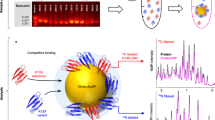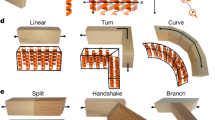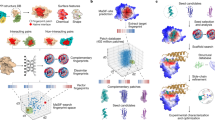Abstract
Biomimetic nanoparticles are known to serve as nanoscale adjuvants, enzyme mimics and amyloid fibrillation inhibitors. Their further development requires better understanding of their interactions with proteins. The abundant knowledge about protein–protein interactions can serve as a guide for designing protein–nanoparticle assemblies, but the chemical and biological inputs used in computational packages for protein–protein interactions are not applicable to inorganic nanoparticles. Analysing chemical, geometrical and graph-theoretical descriptors for protein complexes, we found that geometrical and graph-theoretical descriptors are uniformly applicable to biological and inorganic nanostructures and can predict interaction sites in protein pairs with accuracy >80% and classification probability ~90%. We extended the machine-learning algorithms trained on protein–protein interactions to inorganic nanoparticles and found a nearly exact match between experimental and predicted interaction sites with proteins. These findings can be extended to other organic and inorganic nanoparticles to predict their assemblies with biomolecules and other chemical structures forming lock-and-key complexes.
This is a preview of subscription content, access via your institution
Access options
Access Nature and 54 other Nature Portfolio journals
Get Nature+, our best-value online-access subscription
27,99 € / 30 days
cancel any time
Subscribe to this journal
Receive 12 digital issues and online access to articles
99,00 € per year
only 8,25 € per issue
Buy this article
- Purchase on SpringerLink
- Instant access to full article PDF
Prices may be subject to local taxes which are calculated during checkout





Similar content being viewed by others
Code availability
All Python codes associated with this study are deposited in the Code Ocean capsule66 at https://doi.org/10.24433/CO.7800040.v1.
References
Morrison, J. L., Breitling, R., Higham, D. J. & Gilbert, D. R. A lock-and-key model for protein–protein interactions. Bioinformatics 22, 2012–2019 (2006).
Baspinar, A., Cukuroglu, E., Nussinov, R., Keskin, O. & Gursoy, A. PRISM: a web server and repository for prediction of protein–protein interactions and modeling their 3D complexes. Nucleic Acids Res. 42, W285 (2014).
Murakami, Y. & Mizuguchi, K. Applying the naïve Bayes classifier with kernel density estimation to the prediction of protein–protein interaction sites. Bioinformatics 26, 1841–1848 (2010).
Gainza, P. et al. Deciphering interaction fingerprints from protein molecular surfaces using geometric deep learning. Nat. Methods 17, 184–192 (2020).
Montoya, M. A PrePPI way to make predictions. Nat. Struct. Mol. Biol. 19, 1067 (2012).
Northey, T. C., Bareši, A. & Martin, A. C. R. IntPred: a structure-based predictor of protein–protein interaction sites. Bioinformatics 34, 223–229 (2018).
Baranwal, M. et al. Struct2Graph: a graph attention network for structure based predictions of protein–protein interactions. Preprint at bioRxiv https://doi.org/10.1101/2020.09.17.301200 (2020).
Chen, K.-H., Wang, T.-F. & Hu, Y.-J. Protein–protein interaction prediction using a hybrid feature representation and a stacked generalization scheme. BMC Bioinformatics 20, 308 (2019).
Sarkar, D. & Saha, S. Machine-learning techniques for the prediction of protein–protein interactions. J. Biosci. 44, 104 (2019).
Wang, Y. et al. Predicting protein interactions using a deep learning method-stacked sparse autoencoder combined with a probabilistic classification vector machine. Complexity 2018, 4216813 (2018).
Kotov, N. A. Inorganic nanoparticles as protein mimics. Science 330, 188–189 (2010).
Pinals, R. L., Chio, L., Ledesma, F. & Landry, M. P. Engineering at the nano–bio interface: harnessing the protein corona towards nanoparticle design and function. Analyst 145, 5090–5112 (2020).
Govan, J. & Gun’ko, Y. K. Recent progress in chiral inorganic nanostructures. Nanoscience 3, 1–30 (2016).
Weininger, D. SMILES, a chemical language and information system. 1. Introduction to methodology and encoding rules. J. Chem. Inf. Model. 28, 31–36 (1988).
Xu, L. et al. Enantiomer-dependent immunological response to chiral nanoparticles. Nature 601, 366–373 (2022).
Cha, S.-H. et al. Shape-dependent biomimetic inhibition of enzyme by nanoparticles and their antibacterial activity. ACS Nano 9, 9097–9105 (2015).
Ravikumar, K. M., Huang, W. & Yang, S. Coarse-grained simulations of protein–protein association: an energy landscape perspective. Biophys. J. 103, 837–845 (2012).
Kmiecik, S. et al. Coarse-grained protein models and their applications. Chem. Rev. 116, 7898–7936 (2016).
Wang, Y. et al. Anti-biofilm activity of graphene quantum dots via self-assembly with bacterial amyloid proteins. ACS Nano 13, 4278–4289 (2019).
Acosta-Tapia, N., Galindo, J. F. & Baldiris, R. Insights into the effect of Lowe syndrome-causing mutation p.Asn591Lys of OCRL-1 through protein–protein interaction networks and molecular dynamics simulations. J. Chem. Inf. Model. 60, 1019–1027 (2020).
Verma, M. K. & Shakya, S. LRP-1 mediated endocytosis of EFE across the blood–brain barrier; protein–protein interaction and molecular dynamics analysis. Int. J. Pept. Res. Ther. 27, 71–81 (2021).
Li, Z. L. & Buck, M. Modified potential functions result in enhanced predictions of a protein complex by all-atom molecular dynamics simulations, confirming a stepwise association process for native protein–protein interactions. J. Chem. Theory Comput. 15, 4318–4331 (2019).
Liu, Y. et al. A compact biosensor for binding kinetics analysis of protein–protein interaction. IEEE Sens. J. 19, 11955–11960 (2019).
Moscetti, I., Cannistraro, S. & Bizzarri, A. R. Surface plasmon resonance sensing of biorecognition interactions within the tumor suppressor P53 network. Sensors https://doi.org/10.3390/s17112680 (2017).
Verboven, C. et al. Actin-DBP: the perfect structural fit? Acta Crystallogr. D 59, 263–273 (2003).
Dolinsky, T. J. et al. PDB2PQR: expanding and upgrading automated preparation of biomolecular structures for molecular simulations. Nucleic Acids Res. 35, 522–525 (2007).
Kawabata, T. Detection of multiscale pockets on protein surfaces using mathematical morphology. Proteins 78, 1195–1211 (2010).
Osipov, M. A., Pickup, B. T. & Dunmur, D. A. A new twist to molecular chirality: intrinsic chirality indices. Mol. Phys. 84, 1193–1206 (1995).
May, A. et al. Coarse-grained versus atomistic simulations: realistic interaction free energies for real proteins. Bioinformatics 30, 326–334 (2014).
Vishveshwara, S., Brinda, K. V. & Kannan, N. Protein structure: insights from graph theory. J. Theor. Comput. Chem. 1, 187–211 (2002).
Bahar, I., Atilgan, A. R. & Erman, B. Direct evaluation of thermal fluctuations in proteins using a single-parameter harmonic potential. Fold. Des. 2, 173–181 (1997).
Haliloglu, T., Bahar, I. & Erman, B. Gaussian dynamics of folded proteins. Phys. Rev. Lett. 79, 3090–3093 (1997).
Levy, E. D., Pereira-Leal, J. B., Chothia, C. & Teichmann, S. A. 3D complex: a structural classification of protein complexes. PLoS Comput. Biol. 2, 1395–1406 (2006).
Gavin, A. C. et al. Proteome survey reveals modularity of the yeast cell machinery. Nature 440, 631–636 (2006).
Ye, Q., West, A. M. V., Silletti, S. & Corbett, K. D. Architecture and self-assembly of the SARS-CoV-2 nucleocapsid protein. Protein Sci. 29, 1890–1901 (2020).
Romei, M. G., Lin, C., Mathews, I. I. & Boxer, S. G. Electrostatic control of photoisomerization pathways in proteins. Science 367, 76–79 (2020).
Sachpatzidis, A. et al. Crystallographic studies of phosphonate-based α-reaction transition-state analogues complexed to tryptophan synthase. Biochemistry 38, 12665–12674 (1999).
Ju, J., Regmi, S., Fu, A., Lim, S. & Liu, Q. Graphene quantum dot based charge-reversal nanomaterial for nucleus-targeted drug delivery and efficiency controllable photodynamic therapy. J. Biophoton. 12, e201800367 (2019).
Ahmed, K. B. A., Raman, T. & Veerappan, A. Future prospects of antibacterial metal nanoparticles as enzyme inhibitor. Mater. Sci. Eng. C 68, 939–947 (2016).
Unal, M. A. et al. Graphene oxide nanosheets interact and interfere with SARS-CoV-2 surface proteins and cell receptors to inhibit infectivity. Small 17, 2101483 (2021).
Blanco-López, M. C. & Rivas, M. Nanoparticles for bioanalysis. Anal. Bioanal. Chem. 411, 1789–1790 (2019).
Ma, W. et al. Attomolar DNA detection with chiral nanorod assemblies. Nat. Commun. 4, 2689 (2013).
Kagan, V. E. et al. Carbon nanotubes degraded by neutrophil myeloperoxidase induce less pulmonary inflammation. Nat. Nanotechnol. 5, 354–359 (2010).
Pinals, R. L. et al. Quantitative protein corona composition and dynamics on carbon nanotubes in biological environments. Angew. Chem. Int. Ed. 59, 23668–23677 (2020).
Monopoli, M. P., Pitek, A. S., Lynch, I. & Dawson, K. A. Formation and characterization of the nanoparticle–protein corona. Methods Mol. Biol. 1025, 137–155 (2013).
Madathiparambil Visalakshan, R. et al. The influence of nanoparticle shape on protein corona formation. Small https://doi.org/10.1002/smll.202000285 (2020).
Faridi, A. et al. Graphene quantum dots rescue protein dysregulation of pancreatic β-cells exposed to human islet amyloid polypeptide. Nano Res. 12, 2827–2834 (2019).
Wang, M. et al. Graphene quantum dots against human IAPP aggregation and toxicity: in vivo. Nanoscale 10, 19995–20006 (2018).
Lin, W. et al. Control of protein orientation on gold nanoparticles. J. Phys. Chem. C 119, 21035–21043 (2015).
Ma, C. D., Wang, C., Acevedo-Vélez, C., Gellman, S. H. & Abbott, N. L. Modulation of hydrophobic interactions by proximally immobilized ions. Nature 517, 347–350 (2015).
Horovitz, A. Non-additivity in protein–protein interactions. J. Mol. Biol. 196, 733–735 (1987).
Batista, C. A. S. et al. Nonadditivity of nanoparticle interactions. Science 350, https://doi.org/10.1126/science.1242477 (2015).
Qiao, Y., Xiong, Y., Gao, H., Zhu, X. & Chen, P. Protein–protein interface hot spots prediction based on a hybrid feature selection strategy. BMC Bioinformatics 19, 14 (2018).
Kyte, J. & Doolittle, R. F. A simple method for displaying the hydropathic character of a protein. J. Mol. Biol. 157, 105–132 (1982).
Jumper, J. M., Faruk, N. F., Freed, K. F. & Sosnick, T. R. Accurate calculation of side chain packing and free energy with applications to protein molecular dynamics. PLoS Comput. Biol. 14, e1006342 (2018).
Chakrabarty, B., Naganathan, V., Garg, K., Agarwal, Y. & Parekh, N. NAPS update: network analysis of molecular dynamics data and protein–nucleic acid complexes. Nucleic Acids Res. 47, W462–W470 (2019).
Chakraborty, S., Venkatramani, R., Rao, B. J., Asgeirsson, B. & Dandekar, A. M. Protein structure quality assessment based on the distance profiles of consecutive backbone Cα atoms. F1000Res. 2, 1–12 (2013).
Brancolini, G. & Tozzini, V. Multiscale modeling of proteins interaction with functionalized nanoparticles. Curr. Opin. Colloid Interface Sci. 41, 66–73 (2019).
Hazarika, Z. & Jha, A. N. Computational analysis of the silver nanoparticle–human serum albumin complex. ACS Omega 5, 170–178 (2020).
Samal, A. et al. Comparative analysis of two siscretizations of Ricci curvature for complex networks. Sci. Rep. 8, 8650 (2018).
Eidi, M. & Jost, J. Ollivier Ricci curvature of directed hypergraphs. Sci. Rep. 10, 12466 (2020).
Yang, R. & Bogdan, P. Controlling the multifractal generating measures of complex networks. Sci. Rep. 10, 5541 (2020).
Xiao, X., Chen, H. & Bogdan, P. Deciphering the generating rules and functionalities of complex networks. Sci. Rep. 11, 22964 (2021).
Pedregosa, F. et al. Scikit-learn: machine learning in Python. J. Mach. Learn. Res. 12, 2825–2830 (2011).
Chen, T. & Guestrin, C. XGBoost: a scalable tree boosting system. In Proc. ACM SIGKDD International Conference on Knowledge Discovery and Data Mining 785–794 (ACM, 2016).
Cha, M. et al. Unifying structural descriptors for biological and bioinspired nanoscale complexes [source code]. Code Ocean https://doi.org/10.24433/CO.7800040.V1 (2022).
Acknowledgements
We thank the University of Michigan College of Engineering for support through the BlueSky Initiative and the University of Michigan for access to the HPC resources of the Great Lakes Cluster. Support from the Vannevar Bush DoD Fellowship to N.A.K. (‘Engineered Chiral Ceramics’ ONR N000141812876, ONR COVID-19 Newton Award ‘Pathways to Complexity with ‘Imperfect’ Nanoparticles’ HQ00342010033 and AFOSR FA9550-20-1-0265 ‘Graph Theory Description of Network Material’) is gratefully acknowledged. X.X. and P.B. gratefully acknowledge the support by the National Science Foundation Career award under grant number CPS/CNS-1453860, the NSF awards under grant numbers CCF-1837131, MCB-1936775, CNS-1932620 and CMMI-1936624, the Okawa Foundation research award, the Defense Advanced Research Projects Agency (DARPA) Young Faculty Award and DARPA Director Award under grant number N66001-17-1-4044, a 2021 USC Stevens Center Technology Advancement Grant (TAG) award, an Intel faculty award and a Northrop Grumman grant. The views, opinions, and/or findings contained in this article are those of the authors and should not be interpreted as representing the official views or policies, either expressed or implied by the Defense Advanced Research Projects Agency, the Department of Defense or the National Science Foundation.
Author information
Authors and Affiliations
Contributions
N.A.K conceived the project. M.C., E.S.T.E. and N.A.K. designed the descriptor sets and the workflow. E.S.T.E. collected and curated the protein complex dataset. M.C. analysed the protein complex data and computed the CH, GE and GT descriptors. J.-Y.K. contributed to OPD index calculation. X.X. and P.B. contributed to the computation of MFD in GT features. M.C., X.X. and P.B. designed and trained the DNN model and carried out comparative studies of different ML models. M.C. visualized the analysed data. M.C., E.S.T.E. and N.A.K co-wrote the paper. All authors contributed to data analysis, discussion and writing.
Corresponding author
Ethics declarations
Competing interests
The authors declare no competing interests.
Peer review
Peer review information
Nature Computational Science thanks Ning Gu, Häkkinen Hannu and Açelya Yilmazer for their contribution to the peer review of this work. Primary Handling Editor: Ananya Rastogi, in collaboration with the Nature Computational Science team.
Additional information
Publisher’s note Springer Nature remains neutral with regard to jurisdictional claims in published maps and institutional affiliations.
Supplementary information
Supplementary Information
Supplementary Figs. 1–28, Tables 1–6, Sections 1–3 and References.
Supplementary Data 1
Source data for Table 1.
Source data
Source Data Fig. 1.
Source data for distance matrix of protein 1ma9, chain A and B. Source data for computed feature values per protein (1ma9, chain A) residues.
Source Data Fig. 2.
Source data for correlation plot (a,b). Source data for distribution plot (c–e).
Source Data Fig. 3.
Source data for ML performance plot. Tenfold validation for true-positive rate data for Fig. 3b are included in the folder Fig3b_DNN_TPR_SOURCE.
Source Data Fig. 4.
Source data for true and predicted interface residue number (A and B indicate each chain of a protein in a protein complex).
Source Data Fig. 5.
Source data for predicted interface residues for protein and NPs.
Rights and permissions
About this article
Cite this article
Cha, M., Emre, E.S.T., Xiao, X. et al. Unifying structural descriptors for biological and bioinspired nanoscale complexes. Nat Comput Sci 2, 243–252 (2022). https://doi.org/10.1038/s43588-022-00229-w
Received:
Accepted:
Published:
Issue Date:
DOI: https://doi.org/10.1038/s43588-022-00229-w
This article is cited by
-
Development and use of machine learning algorithms in vaccine target selection
npj Vaccines (2024)
-
Designing nanotheranostics with machine learning
Nature Nanotechnology (2024)
-
Rational strategies for improving the efficiency of design and discovery of nanomedicines
Nature Communications (2024)
-
Machine learning prediction of organic moieties from the IR spectra, enhanced by additionally using the derivative IR data
Chemical Papers (2024)
-
Domain-agnostic predictions of nanoscale interactions in proteins and nanoparticles
Nature Computational Science (2023)



